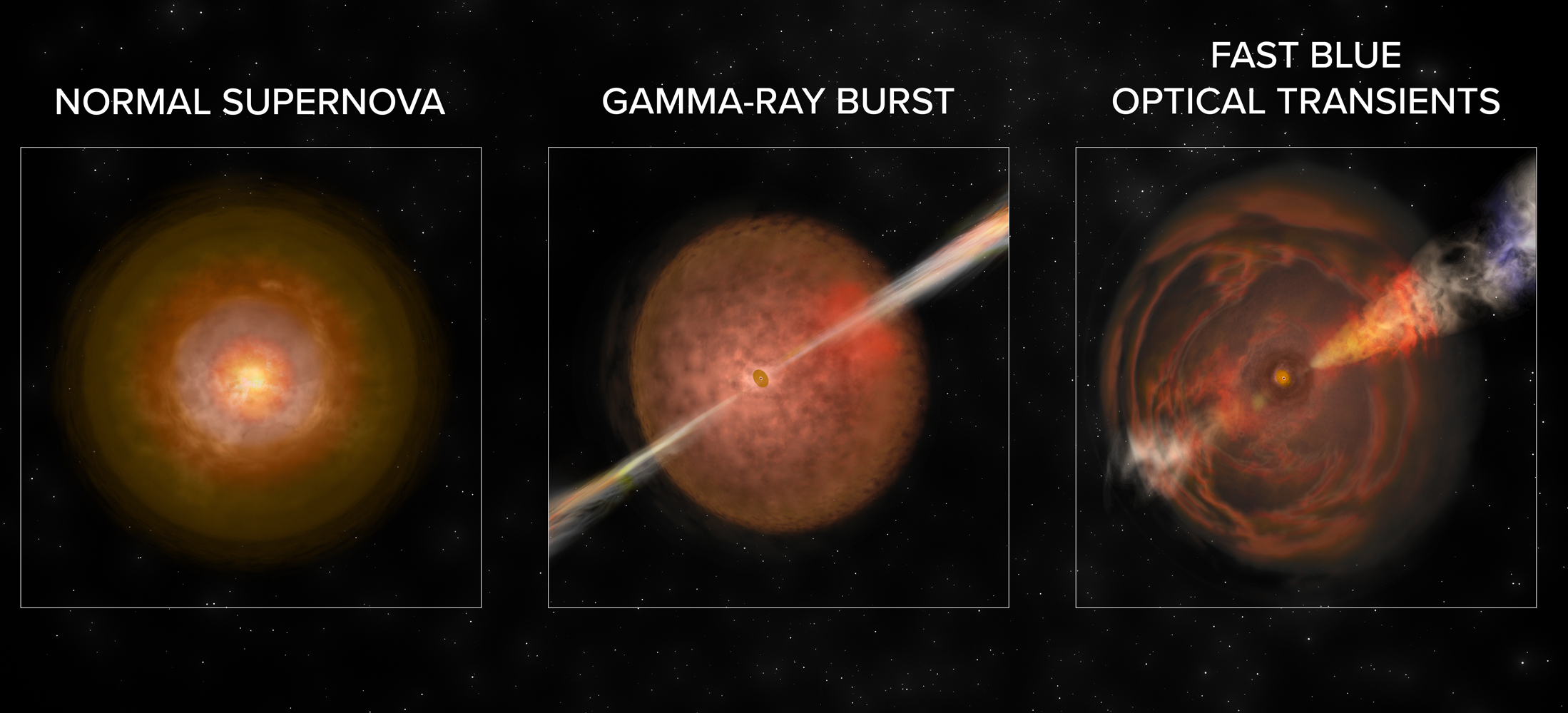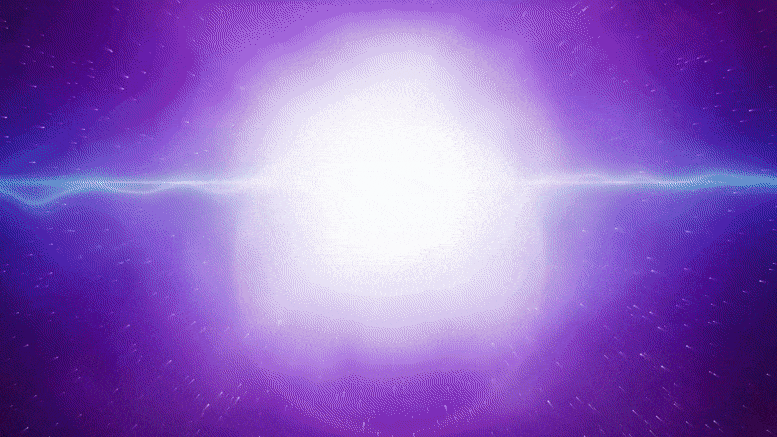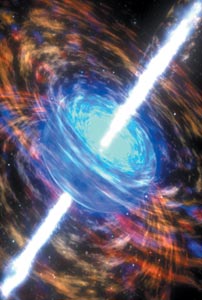A hypernova is a more energetic and powerful type of supernova, releasing even more energy. When comparing supernova vs hypernova, the key differences lie in their energy release and the size of the resulting explosion.
Supernovae occur when massive stars reach the end of their lifecycle and explode, while hypernovae are even more massive and release significantly more energy, often leaving behind a black hole. This distinction showcases the immense power and impact that hypernovae have in the universe, offering unique insights into the life cycles of stars and the phenomena that shape our cosmos.
Understanding these cosmic events can provide valuable knowledge about the nature of our universe and the forces at play within it.

Credit: public.nrao.edu
Types Of Supernovae
Type Ia Supernova
A Type Ia supernova occurs in a binary star system when a white dwarf star accretes matter from a companion star, leading to a thermonuclear explosion.
Type Ii Supernova
A Type II supernova happens when a massive star exhausts its nuclear fuel, resulting in a collapse of its core followed by an intense explosion.
Characteristics Of Supernovae
Brightness And Energy Release
Supernovae are extremely bright cosmic events due to their intense energy release.
Formation Of Neutron Stars Or Black Holes
Supernovae can lead to the creation of neutron stars or black holes depending on their mass.
Differences Between Supernova And Hypernova
Supernova and hypernova are both cataclysmic events that occur in outer space, but they differ in terms of energy release, mass and luminosity, and event duration. Understanding these differences provides a fascinating insight into the forces at work in the universe.
Energy Release
Supernova and hypernova are known for their immense energy release, but the disparity in their magnitudes is astonishing. Supernovae occur when a massive star collapses under its gravity, resulting in a tremendous explosion. These explosions typically release energy equivalent to about 10^43 joules, which is comparable to the total energy output of our Sun over its entire lifespan.
On the other hand, hypernova events dwarf the power of supernovae. A hypernova occurs when a star, at least 30 times more massive than our Sun, experiences a core collapse. These colossal explosions can release energy on the order of 10^46 joules, billions of times greater than that of a supernova. The extraordinary energy unleashed during a hypernova can be seen across vast distances throughout the universe.
Mass And Luminosity
The mass and luminosity of a star play significant roles in distinguishing supernovae from hypernovae. Supernovae primarily occur in stars that have masses ranging from about 8 to 20 times that of our Sun. These events result in a sudden and dramatic increase in brightness, causing the star to outshine its entire galaxy for a brief period.
Conversely, hypernovae are associated with the most massive stars in the universe, those with masses exceeding 30 times that of our Sun. These extraordinary stars burn their nuclear fuel at an astonishing rate, resulting in much higher luminosity compared to supernovae. The intense luminosity of a hypernova is so powerful that it can be observed from hundreds of millions of light-years away.
Event Duration
When it comes to event duration, supernova and hypernova differ significantly. A supernova explosion typically lasts for a few weeks, with the initial blast fading over time. However, the aftermath of a supernova can leave behind a remnant, such as a neutron star or a black hole, which continues to emit energy for millions of years.
In contrast, the duration of a hypernova event is much shorter but far more intense. Hypernovae explosions occur in a matter of minutes, making them incredibly brief on astronomical timescales. However, the energy and intensity of a hypernova outshine all other celestial events, including supernovae, during that short-lived burst of power.

Credit: scitechdaily.com
The Importance Of Supernovae And Hypernovae
Supernovae and hypernovae are breathtaking cosmic events that play a crucial role in shaping our universe. These colossal explosions are not only fascinating to astronomers and astrophysicists, but they also have significant implications for the evolution of stars, the formation of elements, and the structure of galaxies and cosmology.
Stellar Evolution And Element Formation
During stellar evolution, both supernovae and hypernovae mark the dramatic end of massive stars. The intense pressure and temperature within these stars enable the formation of crucial elements such as iron, magnesium, and calcium. These elements are then dispersed into the interstellar medium during the explosion, ultimately contributing to the formation of new stars, planets, and even life.
Impact On Galaxies And Cosmology
The immense energy released during supernovae and hypernovae has a profound impact on galaxies and the overall structure of the universe. These explosions can trigger the formation of new stars and influence the distribution of matter within galaxies. Furthermore, their luminosity and spectral characteristics serve as distance indicators, allowing scientists to measure cosmic distances and gain insights into the expansion of the universe.

Credit: physicsworld.com
Frequently Asked Questions Of Supernova Vs Hypernova
What Is The Difference Between A Supernova And A Hypernova?
A supernova is a massive explosion of a star, while a hypernova is an even more powerful version of a supernova. Hypernovae are thought to result from the collapse of extremely massive stars.
How Are Supernovae And Hypernovae Formed?
Supernovae are formed from the explosive death of a massive star, whereas hypernovae occur when the core of a particularly massive star collapses, creating an incredibly powerful explosion.
Can Supernovae And Hypernovae Be Observed From Earth?
Yes, both supernovae and hypernovae can be observed from Earth, with astronomers using telescopes to study these events and gather valuable scientific data.
What Are The Implications Of Supernovae And Hypernovae For The Universe?
Supernovae and hypernovae play a crucial role in the evolution of galaxies and the elements present in the universe, contributing to the creation and distribution of heavy elements essential for life. Their explosions also release massive amounts of energy and cosmic rays.
Conclusion
To summarize, Supernovae and Hypernovae are both immensely powerful cosmic events. While Supernovae occur in the final stage of a star’s life, Hypernovae are triggered by the collapse of a massive star’s core. These cataclysmic phenomena release astonishing amounts of energy and shape the universe as we know it.
Through scientific exploration, we continue to unravel the mysteries of these celestial marvels, expanding our knowledge of the vast cosmos. Embracing the awe-inspiring wonders of the universe, we can gain a deeper appreciation for the beauty and complexity of the cosmos.


